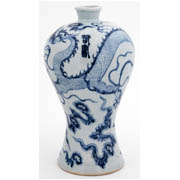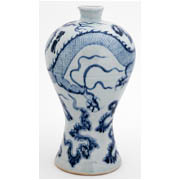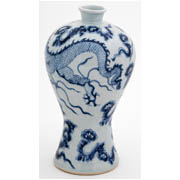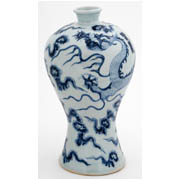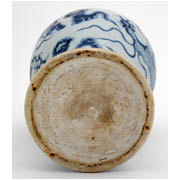Details
- Object type
vase
- Title
Meiping vase
- Place Associated
China, Jingdezhen (place of manufacture); China, Kaifeng (place found)
- Date
Ming Dynasty, Hongwu period, 1368-1398
- Materials
porcelain with underglaze blue decoration
- Dimensions
overall: 368 mm x 210 mm x 210 mm 3460 g
- Description
-
This vase shows a five-clawed dragon above magical fungus-shaped clouds. The term Meiping means ‘plum vase’, so-called because it was thought to be the ideal shape to contain a plum tree branch. An inscription on the shoulder of the vase reads Chun Shou 春壽 in the seal script style, meaning ‘Spring longevity’. The cobalt used to produce the sparkling blue is rich. There is some evidence that cobalt used in such glazes may have been sourced in Persia (Iran). Cobalt was imported into China during the 13th and 14th centuries by sea.
Emperor Zhu Yuanzhang (1328–98) founded the Ming dynasty in Nanjing. His reign, called Hongwu, means ‘Vast Military Power’. Hongwu palace porcelain, as described in Jingdezhen Taolu (Records of Jingdezhen Ceramics), was renowned for its fine, smooth clay and the delicacy of the potting – the way the potter works the clay.
This vase was part of the Hay Collection which was sold at Sotheby’s in London on 25 June 1946. Sir William purchased it for £115 through one of his dealers, Frank Partridge.
Only three other similar vases have been recorded to date – in the Shanghai Museum, China; the Museum of Oriental Ceramics, Osaka, Japan; and in a private Chinese collection.
- Credit Line/Donor
Gifted by Sir William and Lady Burrell to the City of Glasgow, 1944
- Collection
Burrell Collection: Chinese Pottery [Stoneware, Porcelain]
- ID Number
38.433
- Location
Burrell Collection

